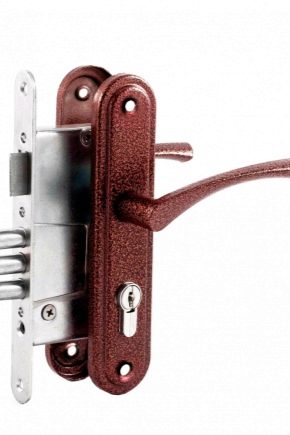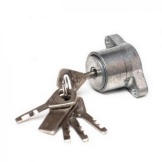Mortise cylinder locks: characteristics and tips for choosing

Mortise cylinder locks are gaining more and more popularity in the construction market. Being quite reliable, but at the same time financially affordable devices, they win the hearts of many buyers.
Of no small importance is the fact that the cylindrical door lock is quite versatile, and even a beginner can easily figure out the mechanism of its operation.
Distinctive characteristics
It is obvious that usually cylinder locks are in the form of a cylinder, however, there are other models. For example, in the construction market, you can find round, drop-shaped or even triangular options.




It should also be noted that this type of locking mechanisms can be installed both by cut-in and overhead ways.
If we talk about the specific mechanisms of the device, then a wide variety of options can be distinguished:
- using a disk;
- pin method;
- framework method;
- by means of a magnet;
- a specialized mechanism of increased complexity (used, for example, for safes or vaults).
What does it consist of?
In order to better determine the choice of the lock, it is necessary to study not only the external, but also the internal characteristics of the device. To do this, you should take a closer look at the structure of the structure.
So, to begin with, it should be noted that a lock of this type consists of two main parts: cylinder and executive.


From the outside, the lock is usually covered with brass, however, there are also galvanized options. Usually, the outer wall is made thick enough to avoid easy penetration into the inner part and, consequently, its damage.
Inside the castle there are specialized devices that serve as bolts. These bolts are of two types:
- crossbar - specialized elements that, at the moment of closing the door, are placed in the bolts intended for them (the number of crossbars determines the degree of reliability of the lock);


- latch - holds the lock in the closed position, entering the door frame body.


In addition, the cylinder lock, like any other, has a lever, with the help of which the opening or closing procedure is performed.
The locking device also includes two strips: frontal and locking. They play the role of fastening, they have holes for a key.
The final element of each lock is a key. Without it, the full-fledged work of the structure is impossible.
Mechanism
The mechanism of the lock is quite obvious - in order to activate it, you need a key, which, being placed in a specialized and specially designed hole for it, activates the entire device.

However, there are several important details to consider when choosing a particular locking device. So, the key can work only with one or both sides of the lock.
If the key works only on one side of the lock, then it can be called a rotary key. There will be a special lever on the side opposite to the key.
Otherwise, the lock has a two-way opening type. Typically, such a device is typical for mortise locks.
Popular models
There are a large number of companies that produce cylinder locking mechanisms and devices. Before buying, you should definitely consult with the seller and explain to him all the individual features of your door. Thus, you will definitely not be mistaken with the choice.
However, there are several empirically tested products that have proven their reliability and durability. Let's take a look at a few of them.
- Kale 164 BNE-Z - this lock is suitable for a metal door and will protect the owners from unwanted intrusion into the premises. Has two mounting keys, as well as special protection against drilling and selection of the code.
- Kale 164 AS - when it is hacked, an alarm is triggered. It is endowed with six brass pins.
- Kale 164 CEC - has a steel insert, a reversible key and three rows of code elements.
- Apecs XS - a pin is placed inside the cylinder to prevent the lock from being drilled out, and two steel body clamps will save it from pulling out the core.
- Apecs RT - mortise type with eurocylinder and six pins.
- Apecs SC - has an English key type. You can choose a model with a turntable.






Thus, we see that there is a huge variety of cylinder locks - from the simplest standard ones to models with specialized security devices. That is why your choice should be based primarily on what kind of protection you want to provide for the room: whether you install a lock in an ordinary interior door or want to prevent breaking into a safe with securities and material values.
A cylinder lock is a fairly popular and proven device over the years. This type of locking mechanism is presented in the construction market in a huge range. Standard models are attractive due to their low price, while more luxurious types promise reliable protection. In this regard, cylinder structures are in demand among consumers.
For 5 tips on choosing a door lock, see the next video.













The comment was sent successfully.